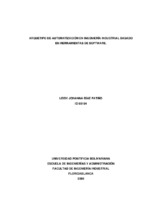| dc.contributor.advisor | Villamizar Araque, Marco Antonio | |
| dc.contributor.author | Díaz Patiño, Leidy Johanna | |
| dc.coverage.spatial | Seccional Bucaramanga. Universidad Pontificia Bolivariana. Escuela de Ingenierías. Facultad de Ingeniería Industrial | spa |
| dc.coverage.temporal | 2009 | |
| dc.date.accessioned | 2013-07-16T21:53:53Z | |
| dc.date.available | 2013-07-16T21:53:53Z | |
| dc.date.created | 2009-10-21 | |
| dc.date.issued | 2013-07-16 | |
| dc.identifier.uri | http://hdl.handle.net/20.500.11912/577 | |
| dc.description | 191p.: (pdf); il; gráficas; tablas; anexos | spa |
| dc.description.abstract | Este documento presenta como resultado un compendio de guías introductorias de automatización aplicables a Ingeniería Industrial basadas en herramientas de software (Promodel, LabVIEW, Solid Edge y WinQSB), con el propósito de fomentar la aplicación de la automatización, en las asignaturas en las cuales es un elemento tecnológico a desarrollar a través de herramientas informáticas. Mediante la construcción del marco teórico, se estableció el papel que juega “aprender haciendo” en el aprendizaje, la estructura de las tareas guiadas y cómo el Ingeniero Industrial tiene en la automatización una herramienta para mejorar los procesos. A su vez el diseño de las guías permitiría ubicar la temática desarrollada en automatización en asignaturas como: Introducción a la Ingeniería Industrial, Introducción al Pensamiento Sistémico, Informática para Ingenieros Industriales, Procesos de Producción, Control de Calidad, Localización y Distribución de Planta, Planeación y Control de Producción y Logística de Distribución, promoviendo la automatización como un campo propicio para la Ingeniería Industrial. Finalmente de la aplicación de la prueba piloto se evidencia cuatro elementos importantes a tener en cuenta en el desarrollo de las guías: el tutor, el estudiante, el software y el hardware. | spa |
| dc.description.abstract | This document contains as a result some compiled guide books that serve as an introduction to automation used in Industrial Engineering. These guides are based on software applications (Promodel, LabVIEW, Solid Edge y WinQSB) and have been produced with the purpose of encouraging automation in those subjects in which, it is a technological element to be developed through information technologies. During the search of previous investigations, it was established: the role of “learning by doing”, the structure of guided homework and how the Industrial Engineer finds in automation a way to improve processes. The design of the guide books also allows the user to find the topic related to automation in subjects such as: Introduction to Industrial Engineering, Introduction to Systems Thinking, Information Technologies for Industrial Engineers, Production Processes, Quality Control, Production Planning and Control, Plant Layout and Distribution logistics. All of this promotes automation as an adequate field for Industrial Engineers. Finally, from the practical testing, four elements were identified as important for the appropriate development of the guides: the tutor, the student, the software and hardware. | spa |
| dc.language.iso | es | |
| dc.publisher | Universidad Pontificia Bolivariana | spa |
| dc.rights | Attribution-NonCommercial-NoDerivatives 4.0 International | * |
| dc.rights.uri | http://creativecommons.org/licenses/by-nc-nd/4.0/ | * |
| dc.subject | Tesis y disertaciones académicas | spa |
| dc.subject | Ingeniería industrial | spa |
| dc.subject | Control de la producción | spa |
| dc.subject | Simulación por computadores | spa |
| dc.subject | Promodel [Programas para computador] | spa |
| dc.subject | Labwiew [Programas para computador] | spa |
| dc.title | Arquetipo de automatización en ingenieria industrial basado en herramientas de software | spa |
| dc.type | bacherlorThesis | spa |
| dc.rights.accessRights | openAccess | spa |
| dc.type.hasVersion | publishedVersion | spa |
| dc.identifier.instname | instname:Universidad Pontificia Bolivariana | spa |
| dc.identifier.reponame | reponame:Repositorio Institucional de la Universidad Pontificia Bolivariana | spa |
| dc.identifier.repourl | repourl:https://repository.unab.edu.co/ | |


